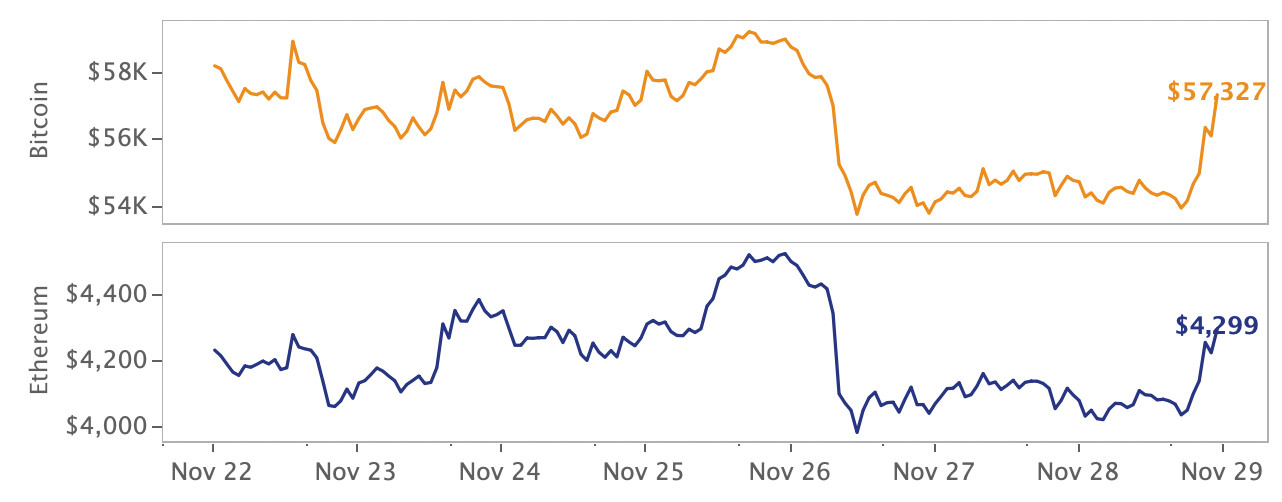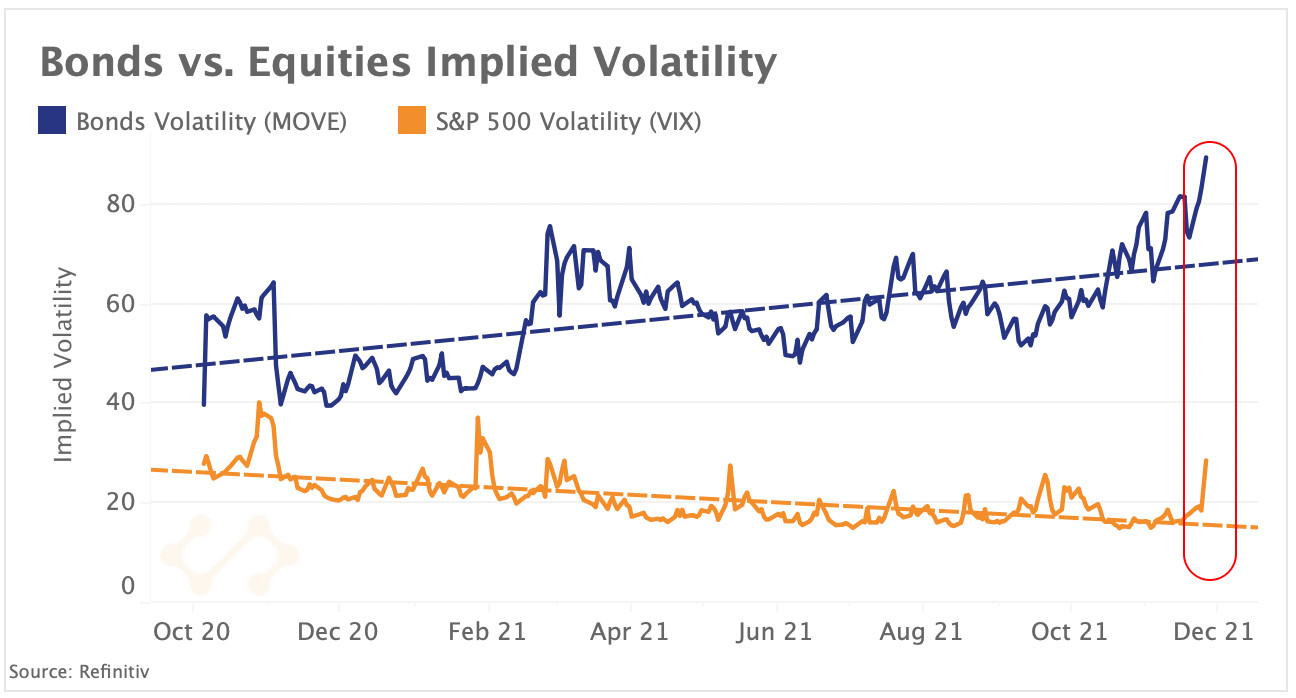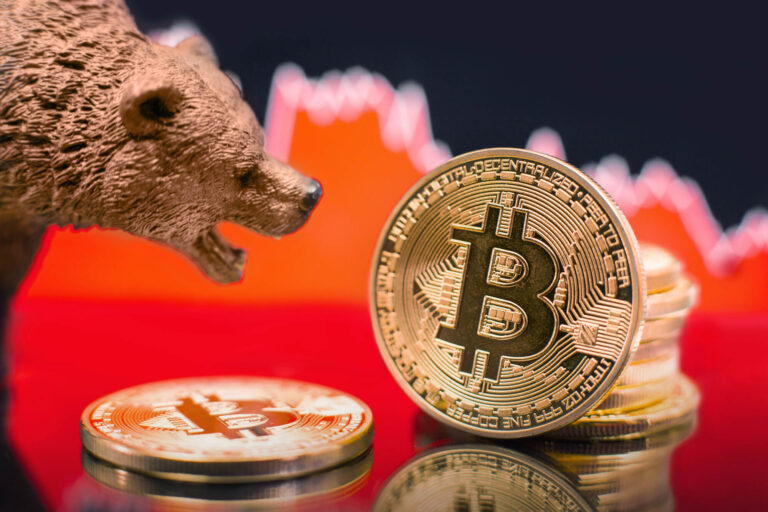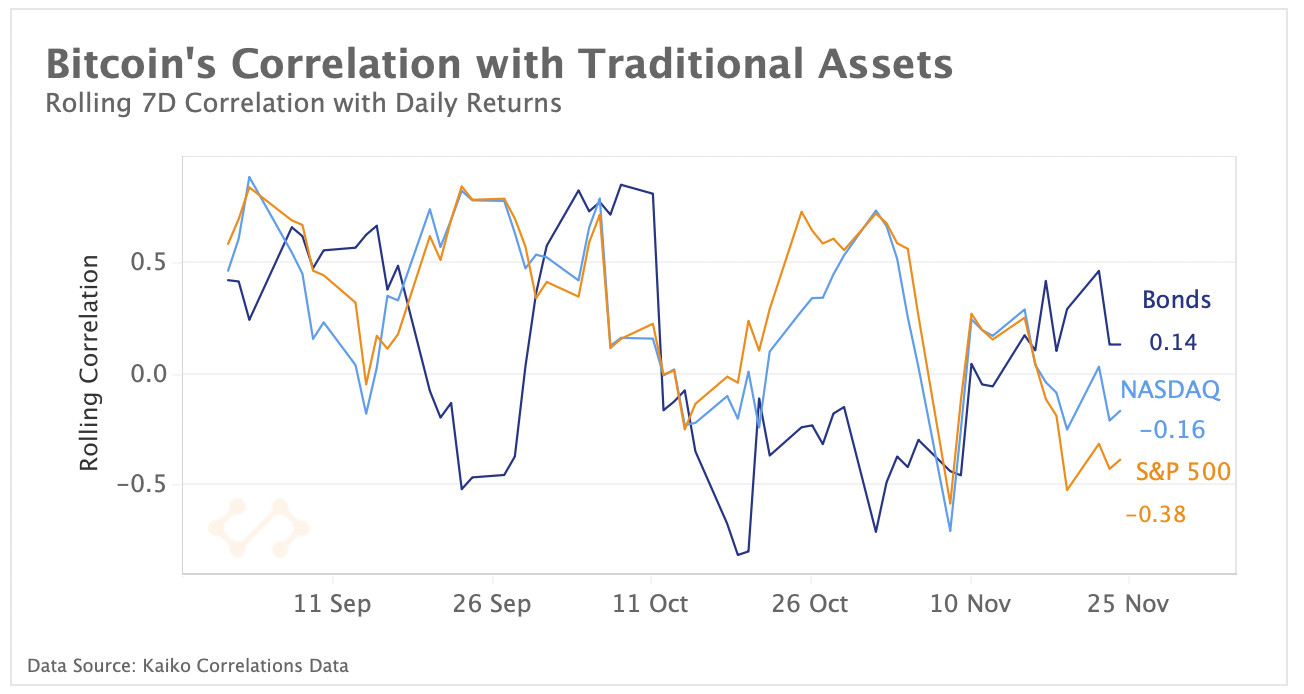A summarizing review of what has been happening at the crypto markets of the past week. A look at trending sectors, liquidity, volatility, spreads and more. The weekly report in cooperation with market data provider Kaiko.
The last 7 days in cryptocurrency markets:
- Price Movements: Crypto markets remain volatile as global risk sentiment plummets.
- Volume Dynamics: We dive into decentralized exchanges, exploring DEX trade volume and how Ethereum transaction fees affect usage.
- Order Book Liquidity: Spreads have become more volatile throughout November for BTC-USD trading pairs.
- Derivatives: Bitmex, once the largest derivatives exchange, has lost market share to Binance and FTX.
- Macro Trends: Bonds rallied and equities plummeted amid renewed lockdown fears due to a Covid variant.
Covid fears shake markets

Both Bitcoin and Ethereum ended the week in the red after the discovery of a new Covid strain in South Africa roiled global markets. Bitcoin’s hourly volatility spiked to its highest levels since early October with BTC dropping by more than 7% on Nov 26, before recovering partially over the weekend. Traditional equities also tumbled while bond prices rallied as investors sought safe havens. Privacy coins and metaverse tokens continued to surge amid the wider crypto sell-off, with ZCash up 9% and SAND up 63%.
In other crypto news, El Salvador announced its plans to build a Bitcoin City, financed by the issuance of $1B of tokenized bonds. Crypto payments infrastructure provider MoonPay raised $555mn in its first funding round at a valuation of $3.4B. Finally, Citigroup intends to hire around 100 people to boost its digital asset team.
The rise of decentralized exchanges
Decentralized exchanges play a major role in the DeFi economy, with thousands of digital assets listed and more than $600b in cumulative volume traded since August 2020. A DEX is a peer-to-peer marketplace where transactions are recorded directly on the blockchain, without any centralized control of order flow. A traditional order book is replaced by liquidity pools that are pre-funded on-chain for both assets of the trading pair (learn more about DEXs here).
Last week, Kaiko launched the industry's first DEX Data Feed, bringing "on-chain" data to "off-chain" distribution. Today, we capture 90% of total DEX trade volume on the Ethereum blockchain, covering five exchanges: Uniswap V2, Uniswap V3, Sushiswap, Curve, and Balancer V1. DEX's are crucial for understanding the growing DeFi sector and we're thrilled to start integrating DEX analysis into our standard CEX coverage.
Uniswap dominating the market
Today, Uniswap V3 accounts for the largest market share of volume (charted above), facilitating $10-$13 billion in volume every week. Overall, DEX volume for the 5 exchanges is on the rise again after peaking in May. Decentralized exchanges (DEXs) first gained popularity in August 2020, and since then volumes have surged from ~$4b / week to ~$20b.
Cumulative volume on DEX's recently surpassed $600 billion, with Uniswap V3 again accounting for the largest market share, despite only launching in May 2021. Uniswap V3 is an upgraded version of V2 that enables better capital efficiency and a flexible fee structure, although some traders still prefer to use Uniswap V2.
While DEXs have undergone a large increase in volume over the past year, how much of market share do they account for in comparison to centralized exchanges? CEXs still account for the majority of total volume in the crypto industry, but some crypto assets are more popular on DEXs.
Above, we chart market share of volume for six assets across all centralized + decentralized exchanges in Kaiko's coverage. We can observe that the stablecoins DAI and USDC are used widely on DEXs. DEXs are less important for (W)BTC - WBTC is a wrapped version of bitcoin that can be traded on the Ethereum blockchain and is pegged 1:1 to BTC - with DEX volume accounting for only 1% of total (W)BTC volume. DEXs account for 14% of total (W)ETH volume, which is quite large considering the fact that DEXs have only recently gained popularity.
Transaction fees on Ethereum
The biggest barrier to adoption that DEXs face today are the high transaction fees on the Ethereum blockchain. Every trader on a DEX must pay Ethereum transaction fees for each trade, which frequently surpass $100 due to congestion and scalability issues. This has restricted DEX usage and we can see this when looking at trade counts.
Daily trade count reveals a lot more about the usage of a DEX compared with trade volume. Today, DEXs process less than 50k trades per day in contrast to centralized exchanges like Binance and Coinbase which process many many millions. Curve and Balancer V1 typically process under 1k trades per day.
What is interesting to note is that although Uniswap V3 has higher volumes, Uniswap V2 actually has a higher trade count. We can also observe that DEX trade volume has surged over the past few months, but trade count has remained relatively flat. The only way this is possible is if the average trade size has increased.
DEXs still have a long way to go before catching up to CEXs, but they have strong potential to shift crypto market structure away from centralized entities. An increasing number of DEXs are being built on Layer 2 protocols and alternate Layer 1 protocols such as Binance Smart Chain and Avalanche, which could make using DEXs less expensive and more attractive to smaller traders.
Bitmex loses market share to Binance and FTX
Last week, we explored how Bitcoin spot volumes have quintupled in less than a year driven by waves of institutional interest and a remarkable shift in crypto sentiment. The same has been true for derivatives markets, which have undergone a similar 5x surge in volume. Above, we chart aggregated Bitcoin future and perpetual future trade volume across three major crypto derivatives exchanges - Binance, FTX and Bitmex.
Binance is clearly the market leader with weekly volumes surpassing $200 Billion. To put this number into context, only $42B worth of Bitcoin trades weekly on spot markets across major crypto exchanges. However, the market share of Bitmex, the exchange which pioneered the Bitcoin perpetual future, has fallen significantly. Bitmex derivatives volume has declined from $12B/week in November 2020 to just $9B today, while FTX and Binance volumes have quintupled over the same time period.
New Covid variant causes market volatility
Both Bitcoin and the S&P 500 plummeted last week while bonds rallied as markets grappled with renewed lockdown fears following the emergence of a new Covid-19 variant. Yields on the 10-year U.S. Treasury note, which move inversely to prices, tanked by more than 16 basis points on Nov 26 to 1.48%, their sharpest drop since March 2020. Above, we chart the implied volatility for the S&P 500 (VIX) and U.S. Treasuries (MOVE).
The implied volatility is the option market’s expectations for near-term price movements and is often used to assess overall market sentiment. A sharp increase in volatility is generally interpreted as preceding a pullback, and vice versa. On November 26, we can observe that the VIX jumped by more than 54% and the MOVE index hit its highest level since the start of the pandemic. The surge in volatility was amplified by low liquidity due to the Thanksgiving holidays in the U.S.
Correlation with traditional financial markets
Overall, bond investors have been more jittery than both equity and crypto investors over the past few months, which suggests monetary policy uncertainty has increased despite central banks still providing ample liquidity. However, Bitcoin's correlation with bonds (charted above) has been stronger over the past few weeks compared with equities.
Bitcoin’s 7-day rolling correlation with the tech-heavy Nasdaq 100 and S&P 500 has been on a downward trend since the start of November, recently hitting a multi-month low of -.6 and -.5, respectively. On November 26th, equities sold off while bonds rallied, and Bitcoin recovered most of its losses over the weekend.














